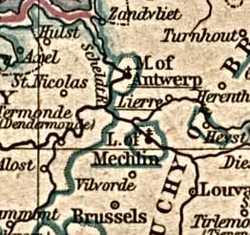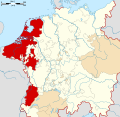This article needs additional citations for verification .(March 2023) |
Lordship of Mechelen | |||||||||||||
|---|---|---|---|---|---|---|---|---|---|---|---|---|---|
| 910–1795 | |||||||||||||
The coat of arms of the Lordship of Mechelen: in 1490, the Emperor Frederick III authorized the addition of the eagle. [2] | |||||||||||||
 The seigneury of Mechelen around Lordship in 1350 | |||||||||||||
 Map of the area from 1559–1608 | |||||||||||||
| Status |
| ||||||||||||
| Capital | Mechelen | ||||||||||||
| Common languages | Dutch | ||||||||||||
| Religion | Catholicism | ||||||||||||
| Government | Feudal Lordship, Principality, Heerlijkheid | ||||||||||||
| Lord of Mechelen | |||||||||||||
• ??? | Huis Berthout | ||||||||||||
| Historical era | Middle Ages, Early Modern Period, French Revolution | ||||||||||||
• foundation and First mention of the Berthouts as lords of Mechelen. | 11th century | ||||||||||||
• Charles III Simple gives the abbey of Mechelen to the bishop of Liège. | 910 | ||||||||||||
• Entry for the first time the dominion of Burgundy and The Prince-Bishopric of Liège cedes Malines to the Count of Flanders. | 1333 | ||||||||||||
• Obtaining county status | 1490 | ||||||||||||
• The Eighty Years' War | 1568 | ||||||||||||
• The French Revolutionary Wars and The seigniory is incorporated into the department of Deux-Nèthes. | 1795 | ||||||||||||
| |||||||||||||
| Today part of | Belgium Antwerp Province | ||||||||||||
The Lordship of Mechelen or Malines [3] [4] (Dutch : Heerlijkheid Mechelen, French : Seigneurie de Malines) was a small autonomous Lordship in the Low Countries, consisting of the city of Mechelen and some surrounding villages. [5] It lasted from 910 to 1795.

